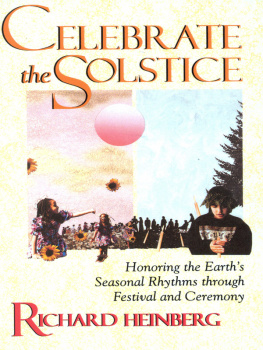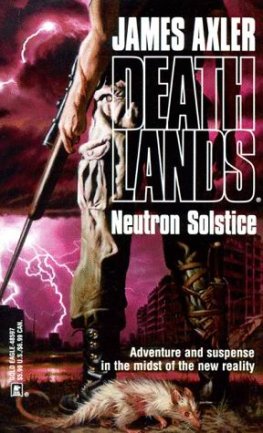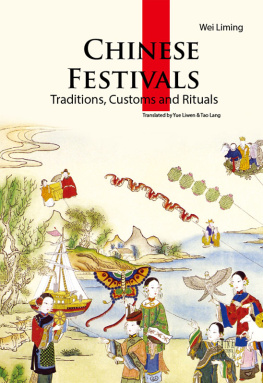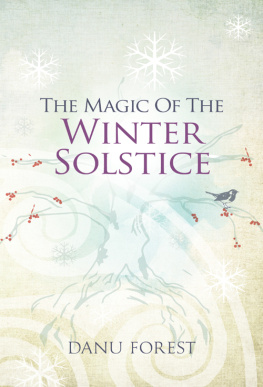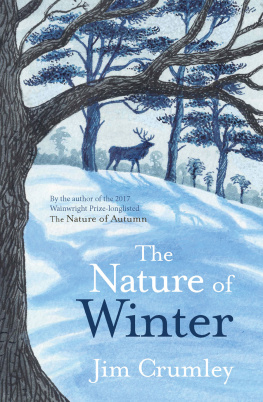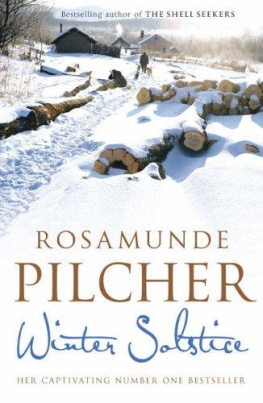
Celebrate
the
S OLSTICE
Celebrate
the
S OLSTICE
Honoring The Earths
Seasonal Rhythms
Through Festival and Ceremony

Richard Heinberg
Foreword by Dolores LaChapelle
A publication supported by
THE KERN FOUNDATION

Learn more about Richard Heinberg and his work at www.richardheinberg.com
Find more books like this at www.questbooks.net
Copyright 1993 by Richard Heinberg
First Quest Edition 1993
Fourth printing
Quest Books
Theosophical Publishing House
PO Box 270
Wheaton, IL 60187-0270
Without limiting the rights under copyright reserved above, no part of this publication may be reproduced, stored in or introduced into a retrieval system, or transmitted, in any form, or by any means (electronic, mechanical, photocopying, recording, or otherwise), without the prior written permission of the publisher of this book.
The scanning, uploading, and distribution of this book via the Internet or via any other means without the permission of the publisher is illegal and punishable by law. Please purchase only authorized electronic editions, and do not participate in or encourage electronic piracy of copyrighted materials.
While the author has made every effort to provide accurate telephone numbers and Internet addresses at the time of publication, neither the publisher nor the author assumes any responsibility for errors or for changes that occur after publication. Further, the publisher does not have any control over and does not assume any responsibility for author or third-party websites or their content.
Library of Congress Cataloging-in-Publication Data
Heinberg, Richard
Celebrate the solstice: honoring the earths seasonal rhythms through festival
and ceremony / Richard Heinberg.
p. cm.
Quest Books
Includes bibliographical references.
ISBN 978-0-8356-0693-6
1. Winter Solstice. 2. Summer Solstice. 3. SeasonsFolklore. I. Title.
GT4995.W55H45 1993
ISBN for electronic edition, e-pub format: 978-0-8356-2129-8
The Solstice Wreath
The grim news has come to my attention
that something in the world has come unfixed
owls no longer haunt the fir-lined alley
appearing out of dreamtime as we pass,
indeed, whole souls are missing, as if being
has itself gone dimlike an old mans seeing.
A vital light is missing from this world, by which I mean
that ephemeral gold that spins the seen
and unseen worlds together. In my life
I dont expect to see a springtime swelling
of the shriveled nut so many human spirits
have become. Whats to be done?
This is the winter solstice of an age,
although the seasons worst is yet to come.
Whats delicate and true has come undone:
is the only fitting answer
a pure and focused rage?
Today I wove a wreath of bone and fir
and filbert withes; twined in sacred holly,
incense cedar from an ancient tree.
I wove, affixed a star, and spoke a spell:
Let this circle stand as the gate of winter
sure passage to the days of lengthening light.
And then I whispered names in the fragrant bough
Lacing love like a scarlet ribbon through the fronds.
Long I wove and dreamed back friends and kin,
each great soul calling back the sun.
I thought at last, My life here is not done.
and some bright star rekindled from within
Sandra Michaelson Brown
It is difficult to be religious, impossible to be merry, at every moment of life, and festivals are as sunlit peaks, testifying, above dark valleys, to the eternal radiance.
Clement A. Miles
Rites,together with the mythologies that support them, constitute the second womb, the matrix of the postnatal gestation of the placental Homo sapiens.
Joseph Campbell
To celebrate a festival means: to live out, for some special occasion and in an uncommon manner, the universal assent to the world as a whole.
Josef Pieper
By returning to the earth itself for the basis of our festivals, we include all the manifestations of Being wherever we live.
Dolores LaChapelle
Acknowledgments
Illustrations on page 116 are by Janet
Barocco; all others are by the author.
Cover artwork by Donnabeth Mitchell
Cover design by Beth Hansen
Book design by Richard Heinberg
The author wishes to thank Sandra Michaelson Brown for
permission to publish her poem, The Solstice Wreath.
FOREWORD
S UMMER SOLSTICE marks the turning point in the suns yearly journey along our horizon. Just when the sun stays longest in the sky, it turns and begins its journey toward winter. For the ancient Chinese, Summer Solstice was the time when the earthly yin (female) energy is born and begins to wax strong while the sun yang (male) energy begins to wane in power. The balance was considered so delicate that everyone took great care to avoid any action which might upset this crucial turning point. No one traveled out of their own valley on the Summer Solstice.
Modern scientific thinking says we cant influence the sun. The sun, however, is not merely an object up in the sky; instead, the changing relationship between the sun and the Earth is the foundation of all life on Earth, and we are upsetting this precarious relationship.
The sun is becoming darker, the Hopi, Loloma told us. Every day there is less light. A few years ago he was invited to a Princeton University Convocation of Indian Scholars where everyone got up and made speeches about the problems of Indians and the future of America, but he thought they were ignoring the true problem. I stood up and all I had to say were seven words, Loloma remembered with a smile. In the East, there is no sun! and he sat down. First there was silence; then everyone applauded. Ever-increasing pollutants in the air cut off some of the sunlight needed to grow plants and may eventually decrease the temperature enough to cause another ice age.
Meanwhile at the other end of the spectrum, we have problems caused by ultraviolet rays from the sun, unfiltered by the ozone layer in the stratosphere, which normally protects the Earth. Chlorofluorocarbons from air conditioners, fire extinguishers and other industrial sources are destroying this ozone layer. More ultraviolet light is already leading to increased skin cancer, cataracts and plant disease. We dont know what further damage may occur, because this invisible, protective ozone layer is what allows life to flourish on the Earth.
Through the years, our Western European industrial culture has belittled the superstitious natives who celebrate solstices and equinoxes to balance their relationship with the sun so that life could continue. But now we know not only how delicate this balance is but that humans do have a role in the relationship between the Earth and the sun.
Now that we are beginning to understand the damage we can do by continuing to ignore the human influence on the earth/sun balance, we need to find a way to begin to restore a healthy relationship with these greater powers. Since the earliest human cultures on earth, this way has been the celebration of the equinoxes and solstices. By celebrating together at these times, we balance the human community as well. A harmonious human community doesnt need consumer products to fill the empty hole in the psyche caused by a lack of real community. In
Next page
